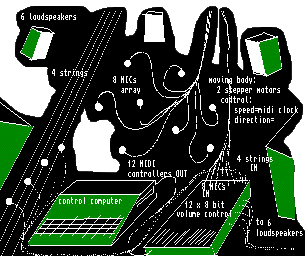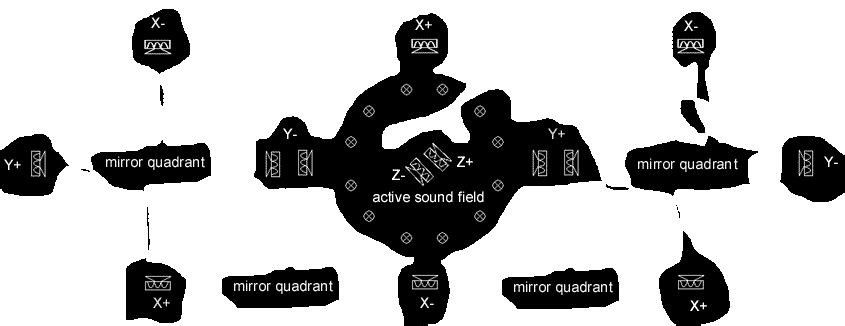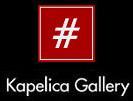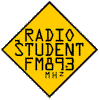BIOTOPE – sound in transition…
a sound installation = performing/social environment
a preliminary sound excerpt (28kbs .ra)
(thought to be original approach, however Steve Reich described the principle already
in 1969!)
OPENING NIGHT @ KAPELICA 15th June – Savski, Grzinich, Zeininger (real video stream)
(you may want to download some more zipped .mp3 files
excerpts from live actions!)
INTRODUCTION
TO THE CONCEPT…
BIOTOPE is a dynamic listening and performative environment; a system of three dimensional sound control. Conceived and developed by sound artists Borut Savski (Slovenia) and John Grzinich (USA), the BIOTOPE project explores the possibilities of how an installation may act as a medium for a human-mechanical-audio system relationship. Installation was premiered in June (14th to 28th) 1999 in Kapelica Gallery, Ljubljana/ Slovenia.
The idea of using acoustically fed-back microphones goes back to 1994. John and Borut met at ARS ELECTRONICA 98 for the first time and found common grounds in certain principles which now result as a BIOTOPE project.
BIOTOPE
synthesizes elements of technology with concepts of autonomous organic systems to be used as a tool for acoustic exploration. Sound acts as the ‘life’ of the system, being both the originating source and the resulting outcome heard by the listener. The installation is maintained in its dynamic balance by a midi sequencing program, that has the ability to take a signal from any of the 12 inputs and re-channel it to any one of the 6 speakers in the room. The sound originates from various objects and devices such as microphones, droning wires and electronics with a performative option of including two people/sound artists as additional instigators. The resulting sound entering the room from the speakers affects the devices (as well as the listeners) and is directly fed back into the system via the input sources. The continually reprocessed sound becomes the changing force, allowing the listener to perceive the evolution of the sound in time.
SYSTEM’s METAPHORES…
The BIOTOPE project has grown out of the artists’ interest in developing models of general systems and theories of autopoietic, or self-referencing systems as they relate to biology, technology and the social sciences. The systems model states that: “life is a system of self-organization, a developmental unfolding at progressively higher levels of differentiation and organized complexity. [This process], more over, is dynamic rather than static, open not closed and searches spontaneously and actively for stimulation rather than passively waiting to respond.”(Bertalanffy, 1952). This is furthered by autopoietic theory, adding the cognitive field of the observer, which is “a consequence of circularity and complexity in the form of any system whose behavior includes maintenance of that selfsame form.” (Maturana & Varela, 1980). These ideas have had a significant impact on restructuring many areas of scientific research in the last half of this century, yet remain unfamiliar to much of the general public. The BIOTOPE project is not an attempt to simulate life (as does artificial intelligence). It is an exploration the qualitative value of congruent change in system interactions which becomes the aesthetical imperative of the artist and the observer. In the whole of this complete audio environment, the listener as ‘cognifier’ becomes as much an aspect of the system as does the creator. The BIOTOPE system allows the visitor
to enter the dynamic process via sound – sound field is the cohesive element.
SOLUTIONS…
In Physics thermodynamic model defines a model of a self-contained, ‘isolated’ system, where the sum of all energies present (kinetic, potential and internal -> of the molecules) remaining CONSTANT, while at the same time a lot of ACTIVITIES may be going on inside. A jump to human systems: what we – the elements/particles (either individual or small systems) PERCEIVE is this very localized activities – the energy changing its various forms (internal to potential to kinetic to… poetic?). What we cannot see is the system as a whole – the EYE from outside (above?). The model of TIME is represented as a SERIES one and is needed to provide a simple and transparent
CAUSAL model of the events. This is then HISTORY (and evolution, dialectics… – they all have bodies the way we relate to them: “the history will remember…”).
More of this kind of talk… in Slovene & CE English
BIOTOPE AS SOCIAL ENVIRONMENT…
While one aim is a ‘self-sufficient’ sound & sound events producing mechanism, no less important complementary aim is to inhabit/appropriate it by humans/artists. In this case the mechanism acts as a ‘not too predictive’ (complex?) instrument for the human ‘inhabitants’ to upgrade. Upgrading it with their ability to form social relations/organisation. Isn’t this an important aspect of life that boasts to be intelligent?
‘INHABITANTS’…
It is a well known fact that public places of relative size that are adequate for electroacoustic sound installations are rarely available – as are already configured systems that are open for explorations. The BIOTOPE installation therefore proves to be more of a working environment (-> ‘work in process’ as M. Kosnik puts it) than a finished object of passive admiration. Apart from the two authors, there were three artists ‘inhabiting’ it/ testing it:
LUDWIG ZEININGER (computer musician, composer)
MARKO KOSNIK (multimedia artist, Egon March Institute)
ZOAMBO ZOET WORKESTRAO (Gregor, Ivo, Alenka, Natasa) -> part of the band crew
ELEMENTS…
Generators:
The basic elements of sound generation is 12 self-generating sources (8 microphones and 4 long wires/strings) – caught in a controlled acoustic feedback loop with any/some/all of the 4 main & 2 auxilliary loudspeakers. Loudspeakers are organised in a form of a quadrant which can be expanded further by ‘mirror’ quadrants (-> images of the basic one).
Generation of multitude of highly random (by way of two computers) sound events in the acoustic area between 4 outer + 2 inner loudspeakers creates a ‘dynamically balanced’ sound field (= ‘white noise’ metaphore -> evenly distributed/non-organized sound events/ but not noise!).
Computer control is performed with two computers on the level of MIDI controllers (Amiga + Emile Tobenfeld’s KCS Levell II and an IBM PC + Miller Puckette’s PD software), a ‘MIDI_to_voltage’ interface (Doepfer MCV24) and a custom built 12in/6out voltage controlled mixing desk.
Perturbators:
The second mechanism – complementary to the above – is the real-time perception of resulting ‘sound field’ by measuring it (by means of 4 ‘receptors’ of differently interpreted sound qualities (volume, pitch, …) and converting it to movement. This transforms the sound field dramatically – closing a ‘loop’ – feeding back – making a system self-referential. Alive? Maybe (depending of the specific theory), but certainly not intelligent.
Receptors are custom built ‘microphone_to_motor’ convertors. Also: they provide ‘analogue’
decisions – contrary to the above digital (-> fast computing) control.
Accumulators and Accelerators:
Accumulation of certain events from the past can in time produce a stronger decision which shakes the dynamically balanced sound field and provides a push into a different kind of ‘balance’. The system as a self-sustaining sound producing entity is receptive also of ‘foreign’ (sound) bodies. It is open for interactions with the ‘outside’ sound.
Aesthetic surplus (measured with humans’ criteria) is expected to happen during a performance. A performance is the inclusion of the sound artists (BSavski, JGrzinich, special guests, friends…) who interact with the flow of sound events and add/convert/dictate the sound field according to artistic decisions. This is the improvisational – realtime – approach. The system retains its own reactions to position, volume, tone and to the events prior to ‘this’ moment and presents an unpredictable ‘entity’ of its own. Artists contribute the dramaturgy, evaluation/reflection/interpretation – in short: intelligence.
John Grzinich (b. 1970) has used wire-based devices, field recordings and processed electronics to create sound elements for performance and studio work since 1993. His interest in sound stems from studies of architecture and design and their relationship to spatial perception and the human environment. Numerous projects and collaborations in the field of installations, performances in USA and Europe, including a vital part in Orogenetics initiative in Austin/Texas.
john@nd.org
Borut Savski (b. 1960) is an ‘engineering soul straying away from any regulated use of technological, social, media and aesthetic principles’. His studies of electronics and radio production work (from 1983) allowed for experimentation with sound and related media. In 1991 he began collaborating with artist Marko Kosnik on projects of the Egon March Institute. Over the past two years he has broadened his work from local to international activities related to the internet as
media and independent radio as public broadcasting space. He currently hosts a regular
broadcast of experimental sound art at Radio Student Ljubljana and is a ‘keeper’ of MINISTRY
OF EXPERIMENT media laboratory.
borut.savski@kiss.uni-lj.si
A PICTURE TELLS MORE…
A pictorial description of the ‘quadrant’ modular logic:
– the basic system element is the central XY quadrant showing 12 sources in circle (symbolicly) and a pair of auxilliary loudspeakers (Z+, Z-) in the very middle.
– the four outputs (X+, X-, Y+, Y-) can provide a total ‘image/mirror’ of the 3D positioning when ‘multiplied’ as shown. The sound field grows according the dimensions demanded by the space volume.
– the system can modulary grow in each direction
– the dimensions of the basic system should be 5 to 10 m in diameter.
Cost-effective solution could be paralleling the X+’s together (and X-‘s and Y+’s and Y-‘s) to one (but more powerful) amplifier. Also: the back_to_back (Y-, Y+) loudspeakers can be a single – more omnidirectional one.
SYSTEM’s RESOURCES:
– 8 microphones, 4 strings/ wires, pickups, MIDI_to_Voltage interface, voltage controlled mixing desk, microphone_to_movement elements, Amiga computer, audio compressor modules…
– 6 x (20 liter) loudspeakers for the basic setup (plus N x 4 loudspeakers
for a the number N of ‘mirroring’ quadrants)
– same number of amplifier channels (40W per channel) with possibility to economize…
– minimal room: 7 x 7 m2, maximal room: 10 x 10 m2 (for basic quadrant)
– Pentium PC running (preferably) Windows NT or Windows 95 (200MHz/ 32MB RAM)
absurdevidence
public domain is an
island of a marginal group of international friends
ministry of experiment is a non-formal initiative currently at RADIO STUDENT
KAPELICA 17th June – Ludwig Zeininger
KAPELICA 18th June – B. Savski
KAPELICA 21st June – B. Savski
KAPELICA 25th June – B. Savski
KAPELICA – 25th June – Zoambo Zoet Workestrao
 my RSS
my RSS



